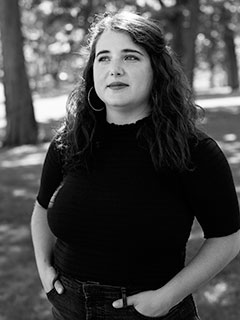Counting down the top 10 most-viewed posts of 2022...here's #4, a Q&A with Elly Fishman first posted on Nov. 4, 2021.
Elly Fishman is the author of the new book Refugee High: Coming of Age in America. It focuses on Chicago's Roger C. Sullivan High School. Fishman worked as a senior editor and writer at Chicago magazine, and now teaches in the Journalism Department of the University of Wisconsin, Milwaukee. She lives in Milwaukee.
Q: You note that you were inspired to write about immigrant and refugee life in Chicago following protests in 2017 about Trump's immigration and refugee policies. What led you to Sullivan High School?
A: I had been reporting out of Chicago for a number of years at that point and had written about different schools. I called my network and asked around where refugee and immigrant kids went to school.
I realized Rogers Park was the landing point for so many refugees in the city. Sullivan was their neighborhood school.
I was encouraged to reach out to [principal] Chad Adams; our mutual contact knew him and said he probably would be open to a story at Sullivan.
Q: How did you choose the students on whom you focused in the book, and what do they think of it?
A: I purposefully took my time choosing the students. I wanted to make sure I had several conversations before diving into a multi-year project.
I had done a magazine piece, “Welcome to Refugee High,” and when I came back, a number of kids knew me and introduced me to their friends.
I spent time in the library getting to know the kids and seeing who seemed interested. I also wanted to choose kids with different backgrounds. The resettlement process is so diverse; I wanted windows into different elements, and that their on-the-ground day-to-day experiences would be different enough.
I did use translators, but I didn’t want four translators in school with me every day, so I needed to find kids I could talk to and kids I connected to. We needed to spend a lot of time together.
I tried to stay in touch. Covid has made it hard. [Before that,] I knew if they ignored me for a few days, I could find them in class.
Some have read the book—I tried to get it to all of them. The reactions were really positive in some cases. Some were excited to have their stories out there to help other refugees.
For others, it was more challenging to see their stories on the page. This always comes up when you’re reading someone’s version of you. I encouraged the kids to ask me questions and feel they had agency, but at the end of the day, it’s my version of the story.
Q: What impact did writing this book have on you?
A: So much! Three to four years is a long time. I grew up in Hyde Park, and had written about young people—homeless youth, queer youth—but I had never immersed myself in the refugee experience. I feel I got a global education. I felt like it made me a more empathetic person, a better neighbor. This took me to new places I hadn’t been.
Q: And what do you hope readers take away from it?
A: The reason I chose to write the book through an intimate close lens of young people’s experiences is that this is a narrative we can take to heart.
So much of the refugee issue involves numbers, the big picture—but it’s important to look at life on the ground. It moved me, and I hope it moves readers to be more empathetic and eager to reach out to people in their own communities.
Q: What do you see looking ahead when it comes to immigrants and refugees in the United States?
A: There’s a lot of hope right now after three years of a pretty bleak landscape. I’m so moved by the incredible enthusiasm for helping resettle Afghan refugees in particular. I’m eagerly awaiting the arrival of Afghan refugees in Chicago.
There also are evergreen inherent challenges in finding your path. It’s a different administration but the anti-immigrant rhetoric has not gone away. It’s a continuing challenge. It’s coming up in elections all over Europe.
Refugee crises are not going to end, especially with global warming and political changes. It’s a mix.
Q: What are you working on now?
A: I’m not working on another book yet. I’m hoping to continue to tell more of these stories now that more refugees are entering the country.
I’m thinking about other issues that have emerged as I reported the book and we’re still navigating the pandemic. There are big ideas, but I need to find the story. I’m hoping to send time on the ground doing reporting and see what comes next.
Q: Anything else we should know?
A: Another reason I decided to focus on young people and what their lives looked like was because when I first walked into Sullivan, it was a dynamic, exciting high school with all the elements of high school—flirting, cafeteria cliques, texting.
It upended my image of refugee experiences—images of families fleeing to safety, refugee camps. Those are important, but this complicated that. It humanized the experience. They’re teenagers. There was so much that felt familiar to me. It felt like an important part of the story to highlight.
It shows kids’ resilience—they’re not only defined by the moments of trauma they carry. I wanted to put resilience front and center.
--Interview with Deborah Kalb


No comments:
Post a Comment